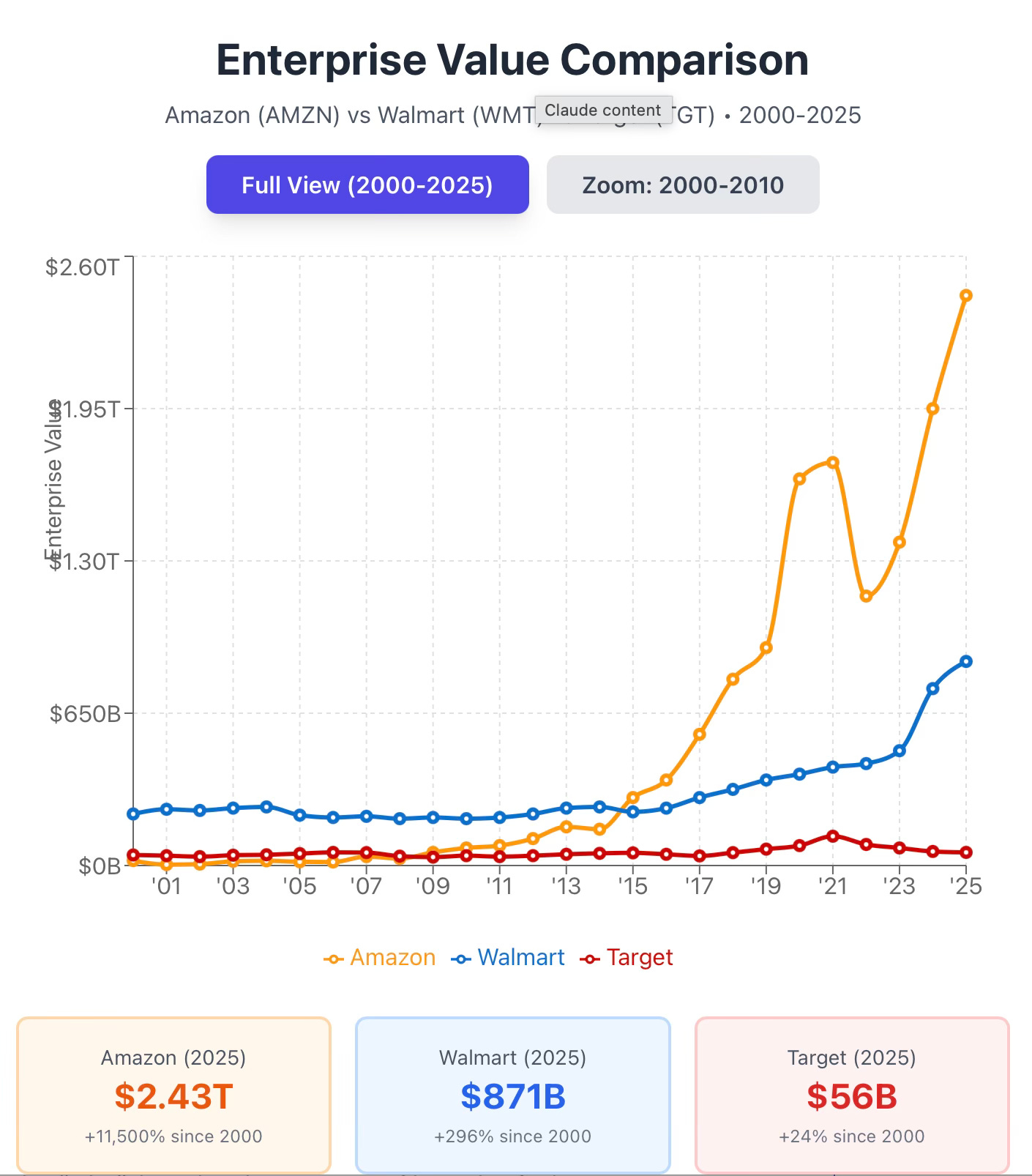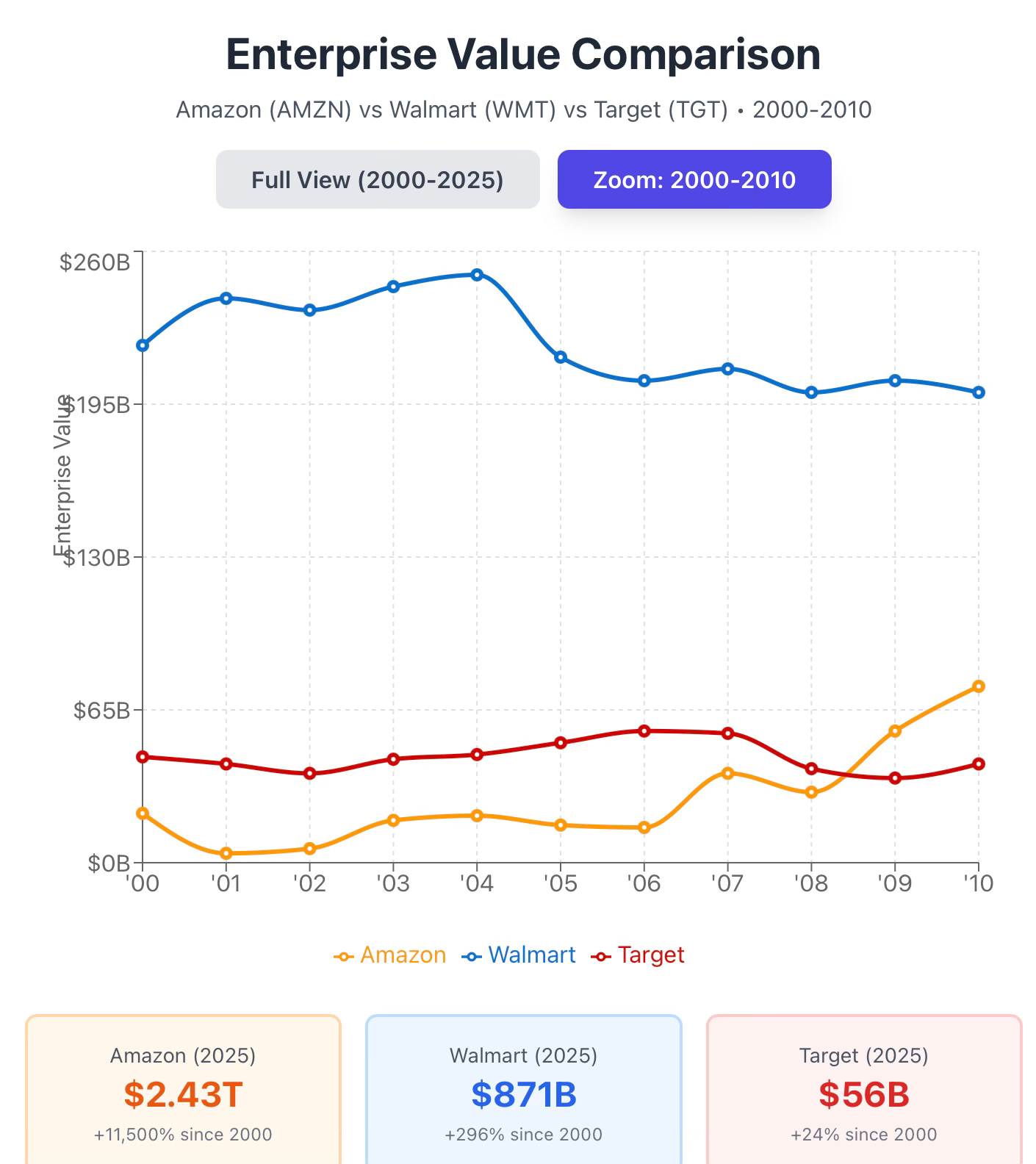It is not the strongest of the species that survives, nor the most intelligent, but the one most responsive to change — Charles Darwin
I was shopping at Target this morning in San Clemente, California. As I walked through aisle after aisle of half-empty shelves, I overheard well-intentioned associates saying things like, “I told the manager about this a month ago.” At checkout, I waited behind six customers while nine registers sat dark and unstaffed.
Standing there, I couldn’t help but ask myself: “What happened to Target?
For decades, Target wasn’t just a retailer; it was a cultural phenomenon — the master of “cheap chic,” the joyful one-stop shop where you could grab paper towels and a surprisingly stylish lamp. Customers even gave it an affectionate nickname: Tar-zhay.
That brand magic, however, has curdled. Target today is a case study in how a beloved brand loses its way through poor decision making— caught in a vicious cycle of operational decay, strategic indecision, and self-inflicted wounds.
The diagnosis is stark: Target is having a severe identity crisis. It is no longer the undisputed leader in style and design, nor is it the cheapest option. It’s stuck in a retail no-man’s-land, and the symptoms are painfully visible both in its stores and on its balance sheet.
The Shattered “Expect More” Promise
The most tangible evidence of Target’s decline is the erosion of its in-store experience. The “Expect More” part of the brand promise once meant clean aisles, helpful staff, and exciting finds. Now, it’s increasingly a story of frustration.
Across the country, shoppers describe disorganized shelves, persistent out-of-stocks, and stores that feel neglected. Customers who once enjoyed browsing now encounter long checkout lines and struggle to find employees for help.
This isn’t just anecdotal — it’s systemic. In its drive to manage costs, Target hollowed out the very experience that differentiated it. As one analyst observes - “out-of-stocks, long wait times at registers, and increasingly messy stores... actively train customers not to shop at Target.”1
Fumbling the “Pay Less” Promise
While the in-store experience crumbled, Target’s “Pay Less” promise was being dismantled by competitors who execute with relentless precision.
As inflation-weary consumers focused on essentials, they turned to Walmart and Costco, both of which have mastered low-cost operations and aggressive value pricing. Over the last 18 months, foot-traffic data show Target’s visits declining while Walmart’s grew.2
Walmart’s investment in omnichannel retail — including same-day pickup and delivery — has strengthened its convenience advantage, while Amazon continues to dominate digital retail with speed and selection Target cannot match.
Caught in the middle, Target has failed to “win” on price, convenience, or experience — leading to nine quarters of flat or declining comparable sales in the last eleven.
A Failure of Leadership
Ultimately, Target’s unraveling is a leadership story.
CEO Brian Cornell, once celebrated for modernizing the company, failed to anticipate the rapid post-pandemic pivots and trends. Target failed it’s brand promise. Target ended up with bloated inventory, markdowns, and margin erosion.
When the board moved to “refresh” leadership, it promoted Michael Fiddelke, a 20-year company veteran, to CEO — while Cornell became Executive Chairman. That move, while framed as continuity, reinforced a culture of groupthink and internal promotion rather than renewal.
This wasn’t a reinvention; it was preservation — a signal that the organization still confuses activity with adaptation.
Target’s Lesson in Missing the Future
Walmart has adapted and has seen enterprise value grow to $871 billion, Amazon exploded to $2.43 trillion, and Target has collapsed to just $56 billion, worth exactly what it was two decades ago. Target didn’t just lose the race to e-commerce and omnichannel retail—it’s the only one of the three that went nowhere while the entire industry transformed around it.
In 2006, Target was worth more than Amazon—$56 billion to Amazon’s $15 billion—while Walmart dominated both at $205 billion.
The Anatomy of Decline: A System Built for Yesterday
Beneath the brand and leadership challenges lies the deeper truth: Target’s operating system — the mechanisms through which it senses, decides, and acts — was designed for a slower, simpler era.
In the age of algorithmic learning and real-time analytics, Target still runs on batch logic: periodic reviews, static reporting, and lagging indicators.
The symptoms are familiar to anyone who’s led a legacy enterprise:
Decision latency — by the time data is reviewed, the moment has passed.
Executional friction — layers of approval slow action.
Systemic misalignment — disconnected metrics create siloed incentives.
The result is organizational entropy: a system optimized for compliance, not curiosity.
Howard Schultz’s clinical diagnosis of Starbucks applies to Target:
And the worst thing that a company can do, like a sports team, is start playing defense because you’re afraid to fail. That is a disease. Not unlike another disease which has happened in Starbucks, which is hubris.
I think, over time, that has happened at Starbucks.”1
Hubris, Inflexibility & The Tyranny of “The Target Way”
Target’s most dangerous trait may be hubris — the conviction that “the Target Way” was synonymous with success.
That mindset, once a strength, hardened into inflexibility. The company became less curious, less experimental, and more reliant on legacy playbooks even as the landscape changed.
The collapse of Target Canada stands as a case study. In 2013, Target launched more than 130 stores in under two years after acquiring 125 Zellers leases. Leadership assumed the U.S. model could simply be replicated.
But, as The Robin Report chronicled, the expansion collapsed under supply chain chaos, empty shelves, and cultural misreads. By 2015, Target exited Canada entirely, taking a $5.4 billion write-off.
It’s a textbook case of hubris over humility — of betting big before validating assumptions.
In Big Bet Leadership, I call this the failure to “Think Big, but Bet Small.” Great leaders hold bold visions but test them through controlled, measurable experiments before scaling.
Target Canada did the opposite. It bet big without thinking small — skipping the proving phase that separates imagination from execution.
Even today, remnants of that mindset persist. Alignment is prized over inquiry; process over experimentation. In an AI-driven world, that rigidity is fatal.
Hubris says, “We already know.”
Big Bet Leadership says, “Let’s experiment and find out.”
Next High-Stake Decision to Not Miss
The “new” CEO, Michael Fiddelke has a short window to separate himself from prior leadership, and chart a bold reinvention path. This is likely harsh medicine with no guarantee of success. But what is the alternative?
Just as I did for Amazon 2022 in this Geekwire article, I offer a blue-print for a turn-around plan for Target. In this case, I used the Big Bets System™ AI Strategy to create this “outside-in” AI-led turnaround plan.
The initiative focuses on three “big bets”:
Associate Copilot — AI tools for frontline employees to prioritize tasks and serve guests more effectively.
Autonomous Retail Engine — dynamic systems for forecasting, pricing, and allocation.
Hyperlocal Moat — using each store as a data node feeding continuous learning back to headquarters.
These moves signal a shift from automation for efficiency to automation for learning — a defining trait of next-generation organizations.
For the entire 27-page detailed playbook, architecture, and economics of this transformation, the full Big Bets System™ AI Turnaround Report expands on this blueprint.
The Leadership Reckoning: High-Stakes Decision-Making in the AI Era
Ultimately, transformation depends on high-stakes decision-making.
Traditional strategic planning — with its stable forecasts and annual cycles — no longer applies in a world defined by volatility and next-generation disruptive technologies. The companies that win will be those capable of making a few high-stakes bets with clarity, speed, and confidence.
This isn’t about prediction; it’s about process — a disciplined approach to navigating uncertainty, de-risking high-ambition initiatives and turn-around plans, and converting chaos into advantage.
That’s the foundation of the Big Bet System™, codified in Big Bet Leadership — an operating system for decisive leadership in complex environments.
Developed based on my time as the Senior Innovation Advisor at T-Mobile and the durable Amazon playbook, the Big Bet System™ gives leaders a repeatable framework to define, decide, and deliver bold outcomes under uncertainty.
For Target — and for every legacy enterprise — the imperative is clear: rebuild the discipline of high-stakes decision-making.
Walmart provides an interesting case study. A titan in retail, its slow response to Amazon’s rise reveals the importance of adaptability. Considering Walmart’s traditional emphasis on operational excellence and financial targets, and their difficulty in changing their store-only model, they have had to become willing to make major leadership adjustments. The CEO, Doug McMillon, says of the challenge, “I’m not naturally a risk taker. I don’t gamble. I don’t jump off bridges with a bungee cord. I don’t. I’m not a risk taker. But this company, to be here in the next generation, has to take risks.”3
If you know a leader at Target, please forward to them. It would be great to see Target hit the bullseye again.
Onward,
John
Author, Big Bet Leadership, The Amazon Way, Think Like Amazon
Your guide to making winning high-stakes decisions in the AI era.
What did I get right? What did I get wrong? Your comments are vital.
Have John talk to your team about the intersection of technology, strategy, culture and the leadership required to win.
https://economictimes.indiatimes.com/news/international/global-trends/us-news-why-target-ousted-ceo-brian-cornell-after-he-turned-the-us-retail-giant-into-a-100-billion-powerhouse/articleshow/123413637.cms?from=mdr
https://www.cnbc.com/2025/05/07/why-american-shoppers-are-picking-costco-and-walmart-over-target.html
Jason Del Rey, Winner Sells All: Amazon, Walmart and the Battle for our Wallets.









Yes, I'm sure there are Target stores that are well stocked. But you can't deny the macro challenges at Target.
Probably the Target store in your town, in McAllen-Mission TX the three local stores are great.